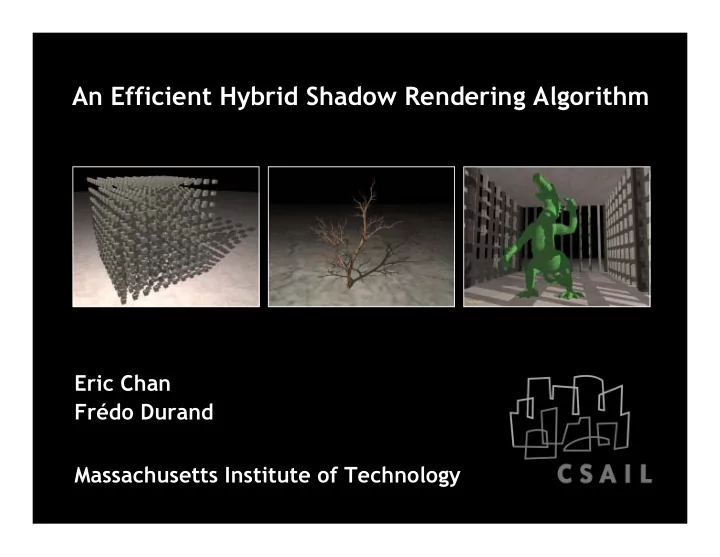

An Efficient Hybrid Shadow Rendering Algorithm Eric Chan Frédo Durand Massachusetts Institute of Technology
Not Another Talk on Shadows?! Main ideas: combination of shadow maps + shadow volumes � computation masks � +
Classic Shadow Algorithms Shadow maps (Williams 1978) fast and simple � undersampling artifacts � lots of recent research! � Shadow volumes (Crow 1977) object-space � accurate � accelerated by stencil buffer � high fillrate consumption! � NVIDIA
Fillrate Problem Lots and lots of fillrate! rasterization � stencil updates � Why? polygons have large screen area � polygons overlap �
Fillrate Problem Lots and lots of fillrate! rasterization � stencil updates � Why? polygons have large screen area � polygons overlap � But is this really a problem?
But Is This Really A Problem? Case study: Doom 3 engine (id Software)
But Is This Really A Problem? Case study: Doom 3 engine (id Software) bump mapping �
But Is This Really A Problem? Case study: Doom 3 engine (id Software) bump mapping � per-pixel surface shading �
But Is This Really A Problem? Case study: Doom 3 engine (id Software) bump mapping � per-pixel surface shading � dynamic and projected lights �
But Is This Really A Problem? Case study: Doom 3 engine (id Software) bump mapping � per-pixel surface shading � dynamic and projected lights � atmospheric effects �
But Is This Really A Problem? Case study: Doom 3 engine (id Software) bump mapping � per-pixel surface shading � dynamic and projected lights � atmospheric effects � particle effects �
But Is This Really A Problem? Case study: Doom 3 engine (id Software) bump mapping � per-pixel surface shading � dynamic and projected lights � atmospheric effects � particle effects � shadow volumes �
But Is This Really A Problem? Case study: Doom 3 engine (id Software) bump mapping � per-pixel surface shading � 50% dynamic and projected lights � atmospheric effects � particle effects � 50% shadow volumes � “Shadowing accounts for about half of the game’s rendering time.” — John Carmack
Two Observations
Two Observations (shadow maps) Shadow-map aliasing is ugly But — only noticeable at shadow silhouettes shadow silhouette
Two Observations (shadow volumes) Shadow volumes are accurate everywhere But — accuracy is only needed at silhouettes few silhouette pixels
Hybrid Approach Decompose the problem: use shadow volumes at silhouettes � use shadow maps everywhere else � shadow map + shadow volume
Algorithm 1. 3. 2. 4.
Algorithm 1. 3. 2. 4. create a shadow map
Algorithm 1. 3. 2. 4. find silhouette pixels
Algorithm 1. 3. 2. 4. apply shadow volumes only at silhouette pixels
Algorithm 1. 3. 2. 4. apply shadow maps everywhere else
Algorithm Details Questions: how to find silhouette pixels? � how to rasterize only silhouette pixels? �
Find Silhouette Pixels Silhouette pixels Look for depth discontinuities Use nearest 2x2 depth samples of the shadow map
Find Silhouette Pixels (example) shadow map query point Check results: � 2 in shadow � 2 visible Disagreement! � silhouette pixel
Restricted Rasterization Use a mask to limit rasterization: tag silhouette pixels in framebuffer � mask off all other pixels � example scene mask
Computation Mask We need a computation mask user-specified mask � hardware early pixel rejection � reduces rasterization, shading, memory bandwidth � normal pixel rejection rasterizer shading pixel tests early pixel rejection framebuffer (e.g. per tile of 4x4 pixels)
Hardware Support Current hardware doesn’t have computation mask but — hardware already has early z culling! � minimal changes needed for native mask support � our implementation uses a simulated mask �
Results 2.6 GHz Pentium 4 � NVIDIA GeForce 6 (NV40) + crazy blue power supply �
Hybrid Algorithm Example Aliased shadow of a ball standard shadow map
Hybrid Algorithm Example Hybrid Algorithm Example Blue and red regions handled by shadow maps visualization
Hybrid Algorithm Example Hybrid Algorithm Example Blue and red regions handled by shadow maps Black and green regions handled by shadow volumes visualization
Hybrid Algorithm Example hybrid algorithm standard shadow map
Test Scenes
Image Quality
Shadow maps
Silhouettes
Reconstruction
Shadow maps Hybrid Time: 5 ms Time: 19 ms
Shadow volumes Hybrid Time: 48 ms Time: 19 ms
Artifacts Low-resolution shadow map discretization errors Misclassified silhouette pixels missing features Difficult cases: fine geometry
Example of Missing Features result visualization 256x256 1024x1024
Discussion Algorithm designed to help fillrate-bound applications: requires an extra rendering pass � 30% to 100% speedup in our test scenes � performance depends a lot on culling hardware � More details in the paper and web page ... tradeoff analysis � comparison to related work � implementation details � more performance and image comparisons �
Summary Hybrid shadow algorithm + Screen-space decomposition: most pixels use fast (but inexact) algorithm � a few pixels use accurate (but expensive) algorithm �
Computation Masks Why? pixels are not created equal � programmer marks “interesting” pixels � fast reject all other pixels � not just for shadows! � useful in general for multipass algorithms � hardware is (mostly) already there �
Acknowledgments Nick Triantos and Mark Kilgard (NVIDIA) Jan Kautz and Addy Ngan (MIT) Timo Aila ASEE NDSEG Fellowship
Recommend
More recommend